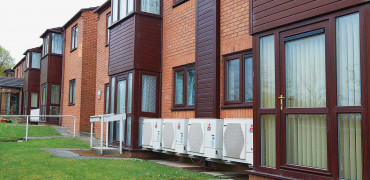By now it should be reasonably safe to assume that the vast majority of us know that in order to decarbonise our housing stock by 2050, then we need to massively upgrade the insulation of our homes and change the way we heat them and provide ourselves with hot water.
We clearly have the knowledge about what is physically needed - insulation of all external surfaces (walls, floors and lofts) needs upgrading, as well as installing double and triple glazed windows, draught excluders and thick curtains, etc.
We also know that our oil and gas guzzling boilers (even those of the condensing variety) will need replacing with new energy efficient boilers and/or heat pumps.
But what’s less clear is how on earth can we do this in a reasonably short timescale and how much will it cost?
The rate of change required looks pretty heroic to me, as it is really ambitious growth
Some basic numbers
Let’s start by taking a look at some of the numbers involved, specifically those concerning how we heat our homes.
There are approximately 25 million domestic properties in England and almost 90 per cent of them use a boiler with radiators or underfloor heating.
About 88 per cent of these boilers are gas powered, with the remainder using oil, electricity, or various other fuels like wood chippings or pellets.
Only about 2 per cent of the current housing stock, or roughly 200,000 homes use a heat pump for space and/or water heating.
The recently announced increases in the price of energy and warnings about more pain to come in six months time, will have further strengthened the case for switching from gas boilers, but the public will need a lot more persuading if we are to adopt new technologies at the speed required to ensure new gas boilers are phased out by the mid 2030s.
Supply chain capacity put under stress
Government Ministers are adamant that the supply chain for delivering new heat pumps is being sorted and it will have sufficient capacity to ensure we can equip and adapt our homes to the needs of a net zero carbon emissions environment over the next 10 years or so.
The rate of change required looks pretty heroic to me, as it means moving from sourcing and delivering 35,000 heat pumps in 2020 to 600,000 units a year by 2028 and then a huge leap to 1.7 million new heat pumps a year by the mid-2030's.
Wow, now that really is ambitious growth.
Last October, the chancellor Rishi Sunak, promised to kickstart the process by subsidising the cost of installing up to 90,000 heat pumps (at an average subsidy of £5k each) to equalise consumer costs in the early years of transitioning from gas and oil powered boilers to the new range of heat pumps.
A costly transition
Thereafter it is hoped that by 2030 traditional boilers and heat pumps would be priced comparably, but that looks like a very big and optimistic assumption to me and I suspect more (and bigger) subsidy programmes will be needed to persuade millions of us to ditch our gas boilers sooner rather than later.
Over a quarter of our existing gas boilers were installed in our homes in the last three years. Their expected life span is 15 years and these boilers represent one of the biggest investments we make in our homes.
The current heat pump subsidy programme looks quite big, but it only amounts to £450 million and it’s expected to be spread over the next three years. This figure actually pales into insignificance when compared to the estimated £15 billion spent by the Government on Covid testing in the past year.
Both are dealing with global emergencies, but for some reason the decarbonisation of our heating systems doesn’t appear to have attracted quite the same sense of urgency even though both threaten our future existence as a species on planet earth.
Alternative heating systems
There are other potential carbon-free heating options available for us to consider, but the list is very short, requires a lot more development work and will not be available to ordinary consumers for quite some time.
News about a successful nuclear fusion experiment in Oxfordshire recently generated huge excitement but in all honesty any commercial application of that technology is probably decades away.
Of more immediate interest, the use of hydrogen as an alternative fuel source for domestic heating is also being worked on. But the Government has signalled that it does not expect to be making a decision on hydrogen’s role in heating our homes until 2025 or 2026.
Over the next 3 to 4 years it is overseeing trials to determine the safety, feasibility, costs and benefits of using hydrogen to heat our homes in the future.
Other ‘green projects’ like extending the use of heat networks are also being examined, but in the meantime a huge expectation or dependency has built up that heat pumps will provide most of the cuts in our carbon footprint.
Billions of pounds required
Replacing 22 million individual gas and oil powered boilers in our homes is likely to cost somewhere in the region of £100 to £200 billion, which is a huge sum.
Assuming that sufficient numbers of heat pumps and other heating alternatives can be manufactured over the next couple of decades, we can probably only afford such investment through some innovative combination of public, private and commercial funding.
Allied to this we need to ensure that other parts of the heating systems (pipework and radiators, underfloor or air systems) are compatible with the heat pumps or new hydrogen powered boilers. We also need to ensure that our insulation and other energy saving works have been completed.
Energy efficiency measures
The latest English Housing Survey energy report contained notional figures for the cost of installing all recommended energy efficiency measures into our homes. For the one million homes in SAP rating bands F to G (the least energy efficient) the average cost was £25,000 per property, while for other properties in bands A to E the average cost was half this amount.
When the individual totals are applied to the whole of the country’s housing stock, we are looking at a figure that surpasses the cost of the boiler replacement programme. In fact the combined amount exceeds £400 billion!
These figures are bewilderingly large but we need to urgently press ahead with the work and the investment because at the moment the average English home is producing 4.4 tonnes of carbon dioxide every year, while the one million homes in SAP rating bands F to G are producing 10.8 tonnes of carbon dioxide every year.
In conclusion
The Government has repeatedly committed us to eliminating all of these carbon dioxide emissions by 2050 at the latest.
And in its latest ‘Heat and Buildings Strategy’, the Government issues a call to action, stating that “We need to start the transition now to meet our emission reduction targets cost-effectively, to minimise disruption and maximise the benefits for everyone.”
Delaying action will make it harder to achieve our carbon reduction targets in later years by increasing the emissions reductions required. The Government has so far shied away from compulsion, but if the public is slow to embrace heat pumps and much higher levels of insulation then I can see a time when Whitehall will intervene and become more prescriptive.
Don’t say you haven’t been warned!
Patrick Mooney is editor of Housing Management and Maintenance magazine




